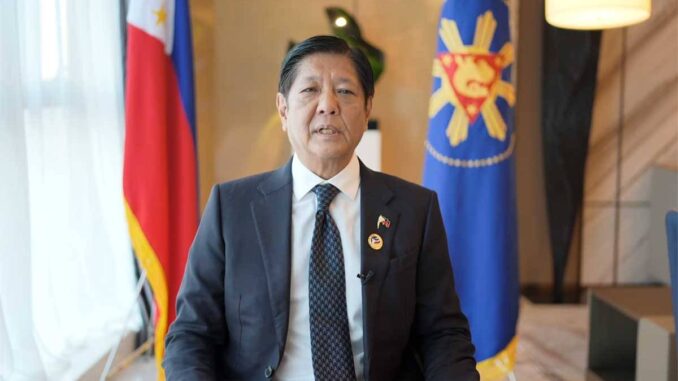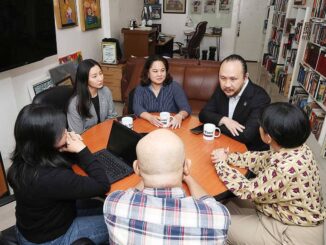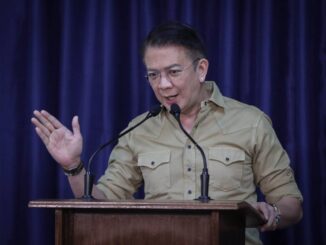
(UPDATES) PRESIDENT Ferdinand Marcos Jr. on Friday night returned to the Philippines from Vientiane, Laos, after obtaining commitments from fellow members of the Association of Southeast Asian Nations (Asean) to find “enduring solutions that would safeguard” their collective future.
The President and his delegation arrived at Villamor Airbase in Pasay City aboard the Presidential plane at around 10:23 p.m.
In his arrival statement, Marcos said the discussions among our partners and friends “were not just about the challenges we face individually, but equally important also about our shared commitment to finding enduring solutions that would safeguard our collective future.”
REGIONAL COLLABORATION President Ferdinand Marcos Jr. reports that the Association of Southeast Asian Nations (Asean) has agreed to enhance regional collaboration on sustainable agriculture, food security and digital transformation in his arrival statement on Oct. 11, 2024. This was among the highlights of his attendance at the 44th and 45th Asean Summits and Related Summits in Vientiane, Laos. SCREENGRAB FROM RTVM
Marcos said he and the other Asean leaders agreed to work closer together in promoting sustainable agriculture to achieve long-term food security.
“We are collaborating with our partners to support our MSMEs through addressing financing gaps and enhancing their capacities to integrate into global supply chains,” he said.
To prepare the country and the region for the future, Marcos said the Asean leaders are together galvanizing the efforts to support the digital transformation of their economies.
“We are shepherding efforts in Asean to promote inclusive and sustainable tourism across the region. These would complement the Philippines’ initiatives in positioning itself as a prime destination for sustainable tourism,” he said.
Marcos also said the Philippines was leading critical initiatives that are significant to the future of this region.
“As host of the Loss and Damage Fund Board, the Philippines is privileged to play a strategic role in supporting the flow of climate finance to countries which are most vulnerable to climate change, as well as advocating for needed support and action on climate resilience,” Marcos said.
“As part of our actions to contribute to help mitigate the devastating effects of climate change, we will be hosting the Asia-Pacific Ministerial Conference on Disaster Risk Reduction next week to cooperate with other countries on disaster preparedness and response,” he added.
The President said he also engaged with the business sector of Asean as well as with representatives of the youth in Asean “in order to exchange ideas on how we can best promote the prosperity and welfare of our people and the entire region.”
Marcos said the Asean leaders also discussed significant international issues and emerging challenges that not only impact our nation but also the entire region, including the West Philippine Sea.
“I reaffirmed that the Philippines will continue to defend our sovereignty, sovereign rights, and jurisdiction in the West Philippine Sea. All Philippine actions are in accordance with international law,” Marcos said.
“The Philippines is continuing to strengthen its partnerships with all countries who share our values and our commitment to peace and the rule of law,” he added.
On the sidelines of the Summit, Marcos said he took the opportunity to engage leaders to discuss bilateral cooperation and strategic areas of mutual interest.
He said they discussed agriculture cooperation with Vietnam, building on recently signed agreements on rice trade, smart agriculture, research and technology, farm management, and sustainability.
The President said he had the opportunity to thank Canada for its consistent support for the Philippines, especially on defense and maritime interests.
“We congratulated Canada on its G7 Presidency and looked forward to the successful conduct of the Team Canada Trade Mission in the Philippines this coming December,” he said.
In a bilateral meeting with New Zealand, Marcos said they explored ways to elevate bilateral cooperation in time for the 60th anniversary of the establishment of diplomatic relations in 2026.
Making full use of their schedule while abroad, he said he also briefly met with the Leaders of Lao PDR, the European Union and Japan and expressed the Philippines’ commitment to further strengthen bilateral relations.
“The Philippine delegation and I are grateful to Lao PDR, the Chair of Asean this year and our generous host, for their successful chairmanship. I look forward to Malaysia’s able leadership as they host Asean in 2025,” he said.
Meanwhile, China has again emphasized its opposition to the US deployment of the land-based Mid-Range Capability missile system in the Asia-Pacific, including the Philippines, in whatever form it may take.
“We hope that relevant parties will see the high sensitivity and harm of this issue, oppose the US’s attempt and move to heighten antagonism and confrontation, stoke an arms race in the region, and jointly uphold the security and stability of the region,” China’s foreign ministry spokesman, Mao Ning, told reporters in Beijing on Oct. 11, 2024.
Mao said that the deployment of offensive strategic weapons at other countries’ doorstep by a nuclear power seriously disrupts regional peace and stability, undermines other countries’ legitimate security interests, and contravenes people’s aspirations for peace and development.
In April, the US Army deployed the Typhoon system to the Philippines. This system can launch missiles such as SM-6 and Tomahawks with a range of over 1,600 km.
“It was the first time the US deployed the Mid-Range Capability missile system outside its territory and in the Asia-Pacific since the end of the Cold War. It was also the first time the US deployed a strategic weapon of this kind after it withdrew from the Intermediate-Range Nuclear Forces Treaty in 2019,” Mao added.
Despite Chinese demands, the United States has no immediate plans to remove the missile system deployed in the Philippines. According to sources with knowledge of the matter, the country is also testing the feasibility of its use in a regional conflict.
The deployment occurred as China and the Philippines, a defense treaty ally of the US, are in conflict over areas in the highly disputed South China Sea. Several confrontations have occurred at sea and in the air in this strategically vital waterway in recent months.
Foreign Affairs Secretary Enrique Manalo assured his Chinese counterpart in July that the missile system’s presence in his country posed no threat to China and would not destabilize the region.
China has fully militarized at least three of several islands it built in the South China Sea, which it mainly claims in full despite a 2016 arbitral ruling that backed the Philippines, arming them with anti-ship and anti-aircraft missiles, the US has said.
China says its military facilities in the Spratly Islands are purely defensive, and it can do whatever it likes on its territory.
On Friday, October 11, US Secretary of State Antony Blinken met with leaders of the Asean bloc and condemned Beijing’s increasingly dangerous and unlawful actions in the South China Sea.
Mao said, “Let me stress that China’s territorial sovereignty and maritime rights and interests in the South China Sea were established over a long period of history and are solidly grounded in history and the law.
She stressed that China and parties to the South China Sea have every capability and wisdom to address disputes adequately through dialogue and consultation and jointly get the situation at sea under control.
“The US and individual countries outside the region are upgrading the deployment of weapons and military activities in the South China Sea to incite confrontation and create tensions. They are the biggest source of instability in the South China Sea,” she pointed out.
China has overlapping claims with Asean members Vietnam, the Philippines, Malaysia, Brunei and Taiwan. About a third of global trade transits through the sea, which is rich in fishing stocks, gas and oil.
A series of recent violent confrontations between China, the Philippines and Vietnam have fueled concerns that China’s increasingly aggressive actions in the sea could spiral into a full-scale conflict.





Be the first to comment